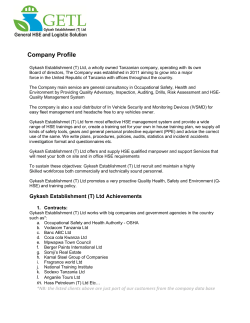
Spring 2015.indd
Linc 15 safe New CDM 2015 Guidance out now! Spring CDM 2015 SUMMARY OF KEY CHANGES The new Construction (Design and Management) Regulations 2015 (CDM Regs) come into force on 6 April 2015 and apply to all building and construction projects, regardless of the size, duration and nature of the work. Client’s Duties Enhanced The new Regulations recognise the influence and importance of the client as the head of the supply chain and as the party best placed to set standards throughout a project. Commercial Clients: • Make suitable arrangements for managing a project. This includes making sure that other duty holders are appointed and sufficient time and resources are allocated. • Appoint both a Principal Designer and Principal Contractor if there will be more than one contractor on site. • Ensure relevant information is pre pared and provided to other duty holders – the client has the main duty for providing pre-construction information (although the Principal Designer is expected to help bring all the information together); • Ensure the Principal Designer and Principal Contractor carry out their duties; • Work for Domestic Clients Now Included CDM 2015 now includes work for domestic clients however a domestic client is not required to carry out the duties placed on a commercial client, instead they will be transferred. Where the project involves: • Only one contractor – that contractor must carry out the clients duties as well as their own; • More than one contractor – the Principal Contractor must carry out the clients duties as well as their own (if a PC is not appointed then the contractor in control of the construction work will take on these duties. Replacement of the CDM Coordinator with a Principal Designer The new Regulations replace the CDM Coordinator with a new role of Principal Designer. This means that the responsibility for planning, managing, monitoring and coordination of the pre-construction phase – which is crucial to the management of any successful construction project – will rest with an existing member of the design team. The Principal Designer can be an individual or an organization that has: • A technical knowledge of the construction industry relevant to the project; • The understanding and skills to manage and coordinate the pre-con struction phase, including any design work carried out after construction begins. Ensure welfare facilities are provided. If a Client fails to appoint a Principal Designer or Principal Contractor then the Client must carry out their duties. If Clients need help in meeting their duties they could draw on the competent advice they are required to have under the Management of Health and Safety at Work Regulations The Principal Designers role involves coordinating the work of others in the project team to ensure that significant and foreseeable risks are managed throughout the design process. They must take into account the principles of prevention and are responsible for preparing the H&S File. CDM 2 Less Prescriptive Definitions for Competency Principal Design Support The previous explicit competence requirements have been removed (Appendix 4 of the old ACoP). Employers will now need to prove that they provide information, instruction, training and supervision, with workers having their training needs assessed against the needs of the job and employers to meet the gap in skills and knowledge through appropriate training. Principal Designers will be required to undertake the previous duties of the CDM Coordinator however some may not feel they have adequate knowledge and experience in relation to the Health and Safety elements of the process. In order to assist those Designers who will be taking on this role, Lincsafe (Health & Safety) will be providing a service to support them. By splitting ‘competence’ into its component parts of skills, knowledge, training and experience, and - if they are an organisation - organisational capability, provides clarity for the industry to assess and demonstrate that construction project teams have the right attributes to deliver a healthy and safe project. Principal Design Support will allow organisations to undertake the role of Principal Designer with the reassurance that they have competent H&S support tailored to their requirements. Construction Phase Plans for All Projects Written construction phase plans will be required for all construction projects (including domestic client work). Even where only one contractor is working on a project a Plan must be compiled – although it should be proportionate to the project. Requirements Where There is More Than One Contractor Both a Principal Designer and Principal Contractor must be appointed when there is more than one contractor on a project. Slight Change in Notification Threshold (<20 persons) Notification to the HSE is required by the Client before works commence. A project is notifiable if the construction work is scheduled to: • OR • Last longer than 30 working days AND have more than 20 workers working simultaneously at any point in the project; Exceed 500 person days Guidance Instead of ACOP The current Approved Code of Practice (ACoP) will be substituted with HSE and Construction Industry Training Board (CITB) Guidance. Main Transitional Arrangements When CDM 2015 comes into force on 6 April 2015, there will be a transitional period that will run for six months from 6 April 2015 to 6 October 2015. For projects starting before 6 April 2015, where the construction phase has not yet started and the client has not yet appointed a CDM Coordinator, the client must appoint a Principal Designer as soon as it is practicable. If the CDM Coordinator has already been appointed, a Principal Designer must be appointed to replace the CDM Coordinator by 6 October 2015, unless the project comes to an end before then. Basically the Principal Design Support role will be similar to the role of CDM Coordinator where Lincsafe are brought in at the concept phase of a project and assist the Client and Principal Designer in the following ways: • Advising the Client and Designers on their duties; • Assisting Designers by helping them to apply the principles of prevention; • Gathering the information required for the pre-construction information,; • Notifying the HSE (where relevant); • Coordinating the design team and encouraging cooperation. Lincsafe will of course continue to support and advise ALL duty holders as it has done over the last 23 years. Further reading CITB have produced Industry Guidance for each duty holder which can be found at: http://www.citb.co.uk/health-safety-and-other-topics/health-safety/construction-design-and-management-regulations/ HSE have released the following guidance which can be found at: http://www.hse.gov.uk/pubns/books/l153.htm HSE PROSECUTIONS Every month we try to highlight issues sourced from different industries, below are this months selection..... E T A D UP Construction firms prosecuted after worker crushed by falling conveyor Three construction companies have been fined after a worker was crushed by a falling section of conveyor at a plant in Sleaford. The incident happened during construction of the Sleaford Renewable Energy plant on Boston Road on 14 February 2013 when the 4.5 tonne conveyor section overturned during installation. It trapped Michael Doyle, a 49-year-old employee of Derbybased Shaw Group UK Ltd, who suffered multiple injuries including four cracked vertebrae, broken ribs, a punctured lung and broken ankle. He has not returned to work since. Lincoln Magistrates’ Court heard yesterday (12 March) that Shaw Group UK Ltd had been subcontracted to install a boiler and associated equipment , including a conveyor system to carry large straw bales, by Burmeister and Wain Energy (BWE). BWE was one of two Danish companies, the other being Burmeister and Wain Scandinavian Contractor (BWSC), that had formed a consortium to design and build the centre, which burns straw and wood to create electricity and also to provide heat for some local authority buildings. Shaw Group UK Ltd had already lifted three conveyor sections on to a slope leading up to the boiler by craning them on to a platform at the bottom of the slope. Skates were bolted to the front and rear legs which helped keep the section of conveyor on rails as it was dragged up the slope by manual winches set up at the top. In order to fix the sections of conveyor in place workers needed to remove the skates and used jacks to raise the legs enough to take the skates off and then lower the legs down onto the rail. This was carried out successfully on the first three sections but as the jacks were released, on the lower legs of the fourth and final section, one side lowered faster than the other and the conveyor swung towards two workers before violently swinging the other way and turning on its side, trapping Mr Doyle, from Fleetwood, Lancashire, underneath. A Health and Safety Executive (HSE) investigation identified safety failings by all three companies. Shaw Group UK Ltd had produced a risk assessment and a plan for the installation but it did not consider removal of the skates from the legs of the conveyor sections or the manual winching of the load up the slope. The document had been sent to BWE for checking but the company did not pick up on the omission. Shaw Group UK Ltd, of Stores Road, Derby, was fined a total of £17,350 and ordered to pay costs of £1,710 after pleading guilty to breaching Regulation 3(1) of the Management of Health and Safety at Work Regulations 1999; Regulation 8(1)(c) of the Lifting Operations and Lifting Equipment Regulations 1998; and Regulation 13(2) of the Construction (Design and Management ) Regulations 2007. Burmeister and Wain Scandinavian Contractor, of Gydevang 35, PO Box 235, DK3450, Allerød, Denmark, was fined £4,670 and ordered to pay costs of £1,710 after pleading guilty to breaching Section 3(1) of the Health and Safety at Work etc Act 1974. Burmeister and Wain Energy, of Luntoftegardsvej 93A, DK 800 Kgs Lyngby, Denmark, was fined £5,350 and ordered to pay costs of £1,710 after admitting a breach of Regulation 13(2) of the Construction (Design and Management) Regulations 2007.1 The lifting operation using jacks was not carried out safely and none of the three defendants was managing or monitoring the work in a way that would ensure its safety. The investigation also found that BWSC failed in its responsibility as principal contractor to ensure work was properly assessed and co-ordinated between the many contractors on site. g http://press.hse.gov.uk/2015/construction-firms-prosecuted-after-workercrushed-by-falling-conveyor/ 2014 Lincsafe (Health & Safety) Limited Road construction firms sentenced after road worker loses arm Three construction firms have been ordered to pay over £400,000 in fines and costs for serious safety failings, after a worker lost his arm when it became trapped in poorly-guarded machinery during a road surfacing operation in Hertfordshire. The 53-year old road worker was preparing a chip spreader – a machine used to scatter stone chips on asphalt – for resurfacing works on the A1001 in Hatfield when his left arm became caught in the machine’s rotating auger, causing serious injuries. The highly-experienced worker, from Rushden, Northamptonshire who does not wish to be named, had to have his arm amputated shortly after the incident and has been unable to return to work since. The incident, on 8 March 2012, was investigated by the Health and Safety Executive (HSE), which prosecuted Amey LG Ltd, Lafarge Aggregates Ltd (acting as Amey Lafarge, a joint venture in charge of the operation) and Ashmac Construction Ltd, who provided workers to the joint venture, for multiple safety breaches at Watford Magistrates’ Court. The court was told (25 March), in order to prepare the chip spreader for use, the worker placed on the site by Ashmac Construction Ltd started the machine and the rotation of its internal auger. During the operation of setting the machine up for use his arm became entangled in dangerous moving parts. HSE’s investigation revealed a series of safety failings on the part of all three companies. HSE found the worker, who was not formally trained in the use of the spreader, and his colleagues were only given one evening to familiarise themselves with the machine by Amey Lafarge when they started work on site six months before the incident. Ashmac Construction Ltd did not take reasonably practicable steps to ensure workers that it placed on site had received appropriate information, instruction and training in the safe use of the chipper they were operating. Amey LG Ltd, of the Sherard Building, Edmund Halley Road, Oxford, was fined £150,015 and ordered to pay costs of £18,000 after pleading guilty to one breach of Section 3(1) of the Health and Safety at Work etc. Act 1974. Lafarge Aggregates Ltd, of Portland House, Bickenhill Lane, Solihull, Birmingham, was fined £175,015 and ordered to pay costs of £18,000 after pleading guilty to one breach of Section 3(1) of the Health and Safety at Work etc. Act 1974. Ashmac Construction Ltd of Pavillion Court, Pavilion Drive, Northampton, was fined £30,015 and ordered to pay costs of £18,000 after pleading guilty to a breach of section 3(1) the Health and Safety at Work etc. Act 1974. Following the case, HSE Inspector Gavin Bull, said: “This tragic incident has left a worker with lifechanging injuries. It was wholly avoidable. The risks associated with plant operating are wellknown in the industry.” “This incident highlights the need for workers to receive the information, instruction and training they need to operate plant safely and for companies to put in place measures to ensure the plant is operated safely on site.” For more information about safety around work equipment and machinery visit http://www.hse. gov.uk/work-equipment-machinery/ or call Lincsafe.1 Amey Lafarge did not give the workers any instruction or training in how to operate the machine safely, including how to secure guards, nor were they given a copy of the operator’s manual for the machine. In addition, there was no safe system of work in place to ensure that the machine was set up and operated properly and that its use was restricted to those who were trained. The Amey Lafarge did have a risk assessment and a site-specific method statement but these did not reflect the reality of the controls in place for the use of the chip spreader. Indeed, the risk assessment described a different type of chip spreader than the one used on site. 1 http://press.hse.gov.uk/2015/road-construction-firmssentenced-after-road-worker-loses-arm-2/ 2014 Lincsafe (Health & Safety) Limited www.lincsafe.co.uk 01673876150 Need to Know in w e n What2s015 news... Lincsafe inhouse news Lincsafe understands the industry is going through somewhat of a increase of workload with the economey improving and adapting to the new CDM2015 regulations. We are here to help clients, and keen to keep them competitive and up to date, so please contact us if you feel you need more tailored training in releation to the CDM 2015 Regulations or any other training. Our 2015 Open Training dates can be found below and also on our website where new dates are regularly updated monthly to suit demand http://lincsafe.co.uk/2014/11/2015open-training-dates/. Asbestos Awareness Cat A UKATA SMSTS REFRESHER 2 day £65.00 pp +VAT July 9th & 10th – £290+VAT May 11th December 7th & 8th £290+VAT August 3rd November 30th SSSTS 2 day IOSH Directing Safely 20th & 21st April – Cost £290.00 pp +VAT inc Books+Certification 8th July 12th 2015 at Lincsafe H&S Ltd – Cost £140+VATpp SSSTS REF – one day IOSH Managing Safely 4 day 26 & 27 May, 2 & 3 June. 2015 £450+VATpp June 12th -£150+VAT per person September 21st £150+VAT per person CITB-ConstructionSkills Dates SMSTS 5 DAY 23rd April, 30th April, 7th May, 13th May & 14th May 2015 – Cost £500+VAT 2014 Lincsafe (Health & Safety) Limited All prices inc Books and Certification; if you would like further information please do contact our office on 01673 876 150 or info@lincsafe.co.uk www.lincsafe.co.uk 01673876150
© Copyright 2024









